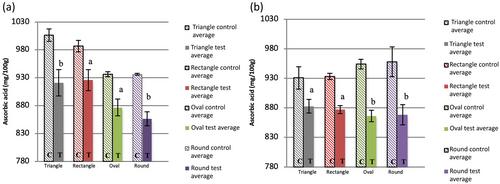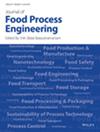The present study aims to investigate how the geometric shapes of semi-rigid plastic trays impact the quality characteristics of a retort processed food simulant. Initially, oval, triangular, rectangular, and round-shaped plastic trays with a tomato-based food simulant were subjected to retorting at rotational speeds of 6 and 11 revolutions per minute (RPM), and various food quality attributes were assessed. At 6 RPM, triangle-shaped and round-shaped trays exhibited a significantly greater reduction (p < 0.05) in ascorbic acid (AA) content compared to oval or rectangular-shaped trays. Furthermore, there were no significant differences (p > 0.05) in lycopene and hydroxymethylfurfural (HMF) content change from control among the different tray shapes at 6 RPM. However, hexanal content change was found to be greater in rectangular-shaped trays than in oval-shaped trays, while no significant difference was observed between triangular and round-shaped trays. Both triangular and rectangular-shaped trays showed a substantially greater (p < 0.05) total color difference (ΔE) compared to other shapes. This data suggests the presence of a temperature gradient in the food simulant influenced by the tray's shape. At 11 RPM, oval and round-shaped trays showed a significant reduction in AA content, while rectangular-shaped trays exhibited higher lycopene levels compared to oval and round trays. There was an increase in HMF response from control across all tray shapes; however, differentiation between shapes was not significant (p > 0.05), while both triangle and round-shaped trays had elevated hexanal content as compared to oval-shaped trays (p < 0.05). Oval, round, and triangle-shaped trays all exhibited a greater ΔE than rectangular-shaped trays. In summary, oval and round-shaped trays exhibited a more pronounced change in AA content at 11 RPM, indicating a faster temperature equilibration. In contrast, triangle and rectangular-shaped trays displayed elevated total color differences at 6 RPM, which may suggest the presence of a temperature gradient leading to uneven heating due to their respective shapes.
This information would be applicable to new food products designed for thermal treatment in which the packaging shape could be manipulated to not only fit infrastructure requirements (packaging equipment, processing equipment, distribution devices) but also help support heat penetration at an optimal rate. Depending on product type and makeup, this approach may hold some value to the product developer whose product will be packaged in semi-rigid plastic containers.



